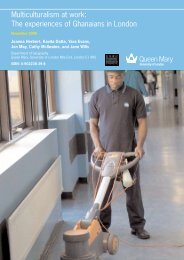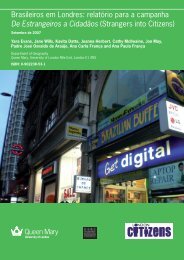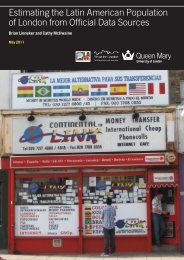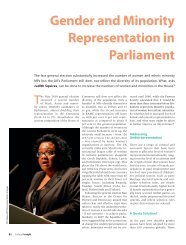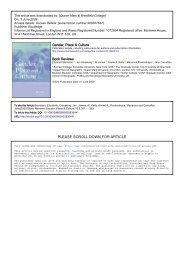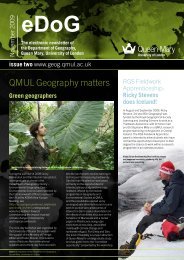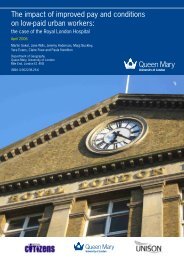The Colombian community in London - Geography - Queen Mary ...
The Colombian community in London - Geography - Queen Mary ...
The Colombian community in London - Geography - Queen Mary ...
- No tags were found...
You also want an ePaper? Increase the reach of your titles
YUMPU automatically turns print PDFs into web optimized ePapers that Google loves.
ACCESSING SERVICES AND ROLE OF MIGRANT COMMUNITY ORGANISATIONS<br />
Access<strong>in</strong>g health care<br />
Although the vast majority of <strong>Colombian</strong>s had access to a GP, it is still significant that 13% did<br />
not. 15 Those without access tended to be irregular migrants who were afraid to approach a GP<br />
for fear of deportation. However, the issue of quality of care is also important. A common<br />
compla<strong>in</strong>t was that health professionals were not <strong>in</strong>terventionist enough and that they often<br />
only prescribed pa<strong>in</strong>killers. For <strong>in</strong>stance, 29 year old Jorge (<strong>in</strong>terviewed <strong>in</strong> 2010) spoke about<br />
how he was treated when he had an ankle <strong>in</strong>jury:<br />
„You should only go to the GP if you are dy<strong>in</strong>g. <strong>The</strong> GP has no use for me, if you sick,<br />
you are sick. I tried to go when I hurt my ankle, I went to an emergency GP and I had<br />
to wait 6 hours as it more swollen and bruised. <strong>The</strong>y told me I wouldn‟t die and to go<br />
home. <strong>The</strong>y did check it but they just gave me a tablet, noth<strong>in</strong>g else, no x-rays,<br />
noth<strong>in</strong>g‟.<br />
This lack of faith is the system is partly reflected <strong>in</strong> the fact that 33% had also used a private<br />
doctor, of which 17% were Lat<strong>in</strong> Americans. 16 Indeed, when asked why they used private<br />
doctors, the largest proportion mentioned a better quality service (50%), followed by trust<br />
(18%) and language (11%) (see Figure 13). Although the numbers are small, it is important to<br />
note that those work<strong>in</strong>g <strong>in</strong> elementary jobs were more likely to use private services (19%) than<br />
those professional and managerial positions (9%). This suggests that <strong>in</strong>come is not a major<br />
reason for such consultation.<br />
Also very important is that 36% of people reported us<strong>in</strong>g health services <strong>in</strong> their home country<br />
when they travelled there. This tended to be dental treatments as well as full physical checkups.<br />
For example, 42 year-old Milena from Cali (<strong>in</strong>terviewed <strong>in</strong> 2007) spoke about how she<br />
returned home every two years to get dental treatment and to see her private doctor who gave<br />
her a full check-up. She also went to a dermatologist.<br />
Figure 13: Reasons for us<strong>in</strong>g private doctor<br />
Better quality service<br />
Lack of papers<br />
Language<br />
Trust<br />
Other<br />
Source: Questionnaire survey (N=28)<br />
15 GP practices have discretion on who to register as patients. However, hav<strong>in</strong>g a legal immigration<br />
status is not a requirement for register<strong>in</strong>g.<br />
16 In the UK as a whole the vast majority of consultations with a doctor are done through the NHS<br />
rather than privately. For example, <strong>in</strong> the General Lifestyle Survey 2008 only 3% of people who<br />
reported see<strong>in</strong>g a doctor <strong>in</strong> the 14 days before the survey went to a private doctor.<br />
28



